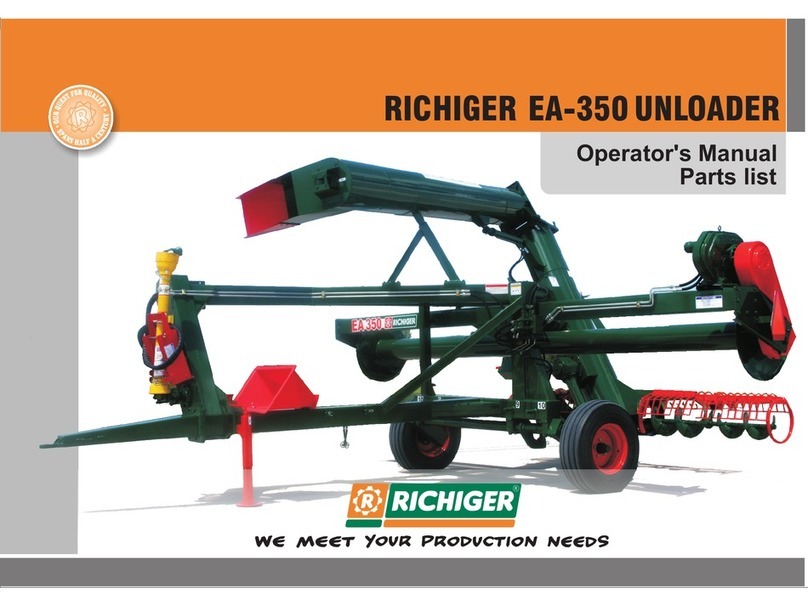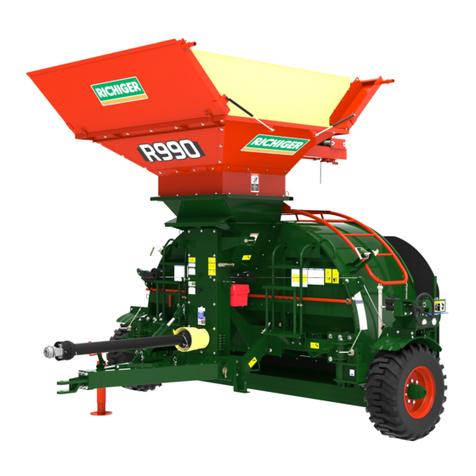
This warranty is expressly in lieu of any other warranties, express or implied, including any warranty of merchantability
or fitness for a particular purpose.
Buyer's sole and exclusive remedy under this warranty shall be limited to the repair, replacement or exchange of
warranted parts at our option, F.O.B. our factory, or designated service center, agent or representative. If the agent or
representative grants any warranty greater in scope or time period or labor allowance than that detailed herein,
RICHIGER MAQUINARIAS S.A shall not be liable beyond the herein stated limitations.
Equipment and accessories not of our manufacture are not covered by this warranty. Any claim with regards to
defective aforementioned equipment and accessories shall be submitted by RICHIGER MAQUINARIAS S.A to the
original manufacturers for analysis and subsequent non-approval or approval of repair, replacement or exchange, at
their option.
No special, incidental, consequential or other damages or contingent liabilities including, but not limited to, loss of life,
personal injury, loss of crops, loss due to fire or water damage, loss of business or business income, down time costs
and trade or other commercial loss arising out of the failure of product. The term product and products as used in this
warranty designates the whole finished unit in its entirety, i.e. the complete assembled machine, and/or all and every
individual component, part, equipment and accessory that forms said complete assembled machine.
Normal wear and tear associated with use is expressly excluded from this warranty.
No products shall be returned without prior authorization from RICHIGER MAQUINARIAS S.A.
Buyers and their agents shall prepay all transportation charges for the return of such products to RICHIGER
MAQUINARIAS S.A or designated service center. There will be no acceptance of any charges for labor and/or parts .
incidental to the removal and remounting of product repaired or replaced under this warranty.
This warranty does not cover conditions over which RICHIGER MAQUINARIAS S.A has no control including, without .
limitation, contamination, pressures in excess of the recommended maximum, products damaged or subject to
accident, abuse or misuse after shipment from factory, products altered and repaired by anyone other than RICHIGER
MAQUINARIAS S.A factory personnel or representative or source approved by RICHIGER MAQUINARIAS S.A in .
writing prior to commencement of said work.
The first buyer is responsible for proof of delivery date of product for the purpose of establishing warranty time of
validity. Warranty can continue for new user should the product be resold by the first buyer during valid period of
warranty, only if this situation is reported in writing, with enclosed documentation as proof of purchase. Warranty will
not be applicable if series number or other identification markers are erased, obliterated or otherwise altered.
Warranty terms
Warranty policy
Limitations on Warranty
Unit: Hydraulic-Mechanical Grain Bag Unloader
Model: EA-910
RICHIGER MAQUINARIAS S.A, located in Avellaneda 661, Sunchales, Santa Fe province, Argentina, warrants its
product EA-910 mechanical grain unloader from defects in materials and workmanship under normal operating
conditions and proper application, in accordance with the specifications for operation as described by the
manufacturer, for the period of 365 days from date of delivery to buyer.






























